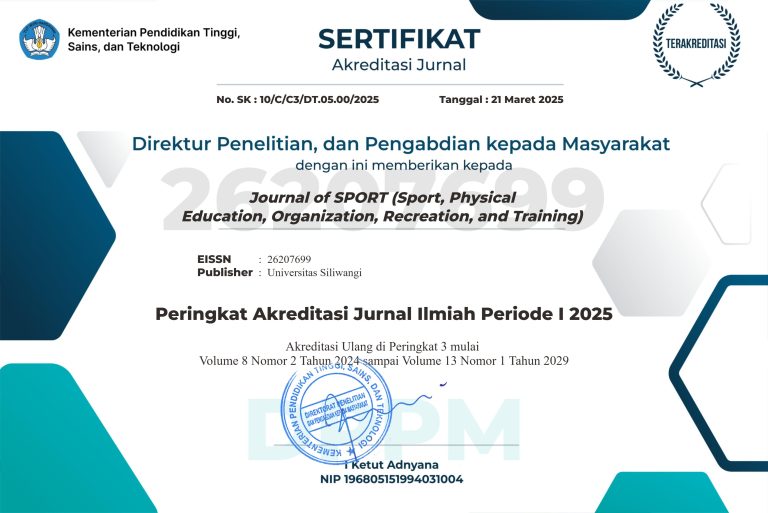PENGARUH MODEL PEMBELAJARAN BERDASARKAN GENDER TERHADAP HASIL BELAJAR GULING DEPAN
Abstrak
Kata Kunci
Teks Lengkap:
PDFReferensi
Akbar, M. (2023). the Influence of Internal and External Factors on Bank Lending. In Indonesian Journal of Multidisciplinary Science (Vol. 2, Issue 4). Atlantis Press SARL. https://doi.org/10.55324/ijoms.v2i4.426
Ali, S. S. (2019). Problem Based Learning: A Student-Centered Approach. English Language Teaching, 12(5), 73. https://doi.org/10.5539/elt.v12n5p73
Bronikowski, M. (2010). Physical Education Teaching and Learning. Public Health, 58(C), 97. https://doi.org/10.1016/s0033-3506(44)80296-7
Bukhari, K., Efendi, Z. M., & Jama, J. (2019). The Development of Physical and Sport Education Learning Model by Using Small Games. Journal of Physics: Conference Series, 1387(1). https://doi.org/10.1088/1742-6596/1387/1/012014
Bulqini, A., Puspodari, P., Arfanda, P. E., Suroto, S., & Mutohir, T. C. (2021). Physical Literacy in Physical Education Curriculum. ACTIVE: Journal of Physical Education, Sport, Health and Recreation, 10(2), 55–60. https://doi.org/10.15294/active.v10i2.47008
Denson, T. F., O’Dean, S. M., Blake, K. R., & Beames, J. R. (2018). Aggression in women: Behavior, brain and hormones. Frontiers in Behavioral Neuroscience, 12(May), 1–20. https://doi.org/10.3389/fnbeh.2018.00081
Dewantara, J., Suhartini, B., & Budayati, E. S. (2023). Problem-Based Learning to Improve 21st Century Collaborative Skills in Physical Education. 6(1), 307–316. https://doi.org/10.35724/mjpes.v6i1.5718
Dunlosky, J., Rawson, K. A., Marsh, E. J., Nathan, M. J., & Willingham, D. T. (2013). Improving students’ learning with effective learning techniques: Promising directions from cognitive and educational psychology. Psychological Science in the Public Interest, Supplement, 14(1), 4–58. https://doi.org/10.1177/1529100612453266
Garrett, T. (2008). Student-Centered and Teacher-Centered Classroom Management : A Case Study of Three Elementary Teachers. 43(2004), 34–47.
Gholam, A. (2019). Inquiry-Based Learning: Student Teachers’ Challenges and Perceptions. Journal of Inquiry & Action in Education, 10(2), 2019.
Gurvitch, R., & Metzler, M. (2013). Aligning Learning Activities with Instructional Models. Journal of Physical Education, Recreation & Dance, 84(3), 30–37. https://doi.org/10.1080/07303084.2013.767719
Jack R. Fraenkel, Norman E. Wallen, H. H. H. (2012). How to Design and Evaluate Research in Education (8th ed.).
Jumaat, N. F., Tasir, Z., Halim, N. D. A., & Ashari, Z. M. (2017). Project-based learning from constructivism point of view. Advanced Science Letters, 23(8), 7904–7906. https://doi.org/10.1166/asl.2017.9605
Kashdan, T. B., Disabato, D. J., Goodman, F. R., & Naughton, C. (2018). The five dimensions of curiosity. Harvard Business Review, 2018(September-October), 1–15.
Kastur, A., Mustaji, M., & Riyanto, Y. (2020). The Practicality and Effectiveness of Direct Learning Model by Using Life-Based Learning Approach. Studies in Learning and Teaching, 1(3), 165–174. https://doi.org/10.46627/silet.v1i3.50
Kuri, E., Posca, E., Rodgers, O., Galili, I., Rose, S., & Willey, N. (2020). Maternal Health and Well-Being. 11(1).
Lee, H. S., & Lee, J. (2021). Applying artificial intelligence in physical education and future perspectives. Sustainability (Switzerland), 13(1), 1–16. https://doi.org/10.3390/su13010351
Leung, H., Shek, D. T. L., Leung, E., & Shek, E. Y. W. (2019). Development of contextually-relevant sexuality education: Lessons from a comprehensive review of adolescent sexuality education across cultures. International Journal of Environmental Research and Public Health, 16(4). https://doi.org/10.3390/ijerph16040621
Quennerstedt, M. (2019). Physical education and the art of teaching: transformative learning and teaching in physical education and sports pedagogy. Sport, Education and Society, 24(6), 611–623. https://doi.org/10.1080/13573322.2019.1574731
Tomlinson, C. A. (2001). How to Differentiate Intructio in Mixed Ability Classrooms (Vol. 44, Issue 1). https://doi.org/10.1016/0300-483X(87)90046-1
Tong, D. H., Uyen, B. P., & Ngan, L. K. (2022). The effectiveness of blended learning on students’ academic achievement, self-study skills and learning attitudes: A quasi-experiment study in teaching the conventions for coordinates in the plane. Heliyon, 8(12), e12657. https://doi.org/10.1016/j.heliyon.2022.e12657
Yew, E. H. J., & Goh, K. (2016). Problem-Based Learning: An Overview of its Process and Impact on Learning. Health Professions Education, 2(2), 75–79. https://doi.org/10.1016/j.hpe.2016.01.004
Yoda, I. K., Wibowo, I. P. A., Rusiawati, R. T. H. D., Kusuma, K. C. A., & Tisna, G. D. (2022). Analysis of Needs for the Development of Physical Education Learning Model in Elementary School Based on Traditional Game. Proceedings of the 4th International Conference on Innovative Research Across Disciplines (ICIRAD 2021), 613(Icirad), 63–68. https://doi.org/10.2991/assehr.k.211222.009
Zaikman, Y., & Marks, M. J. (2016). The Influence of Physical Appearance and Personality on the Exhibition of the Sexual Double Standard. Sexuality and Culture, 20(2), 255–276. https://doi.org/10.1007/s12119-015-9319-9
Zosuls, K. M., Miller, C. F., Ruble, D. N., Martin, C. L., & Fabes, R. A. (2011). Gender Development Research in Sex Roles: Historical Trends and Future Directions. Sex Roles, 64(11–12), 826–842. https://doi.org/10.1007/s11199-010-9902-3
DOI: https://doi.org/10.37058/sport.v8i1.9553
Refbacks
- Saat ini tidak ada refbacks.
##submission.copyrightStatement##
Journal of SPORT (Sport, Physical Education, Organization, Recreation, and Training)
Program Studi Pendidikan Jasmani
Fakultas Keguruan dan Ilmu Pendidikan
Universitas Siliwangi
Jl. Siliwangi No. 24 Kota Tasikmalaya - 46115
email: penjas@unsil.ac.id
e-ISSN: 2620-7699 ; p-ISSN: 2541-7126

This work is licensed under a Creative Commons Attribution-ShareAlike 4.0 International License.
INDEX BY
1.png)












